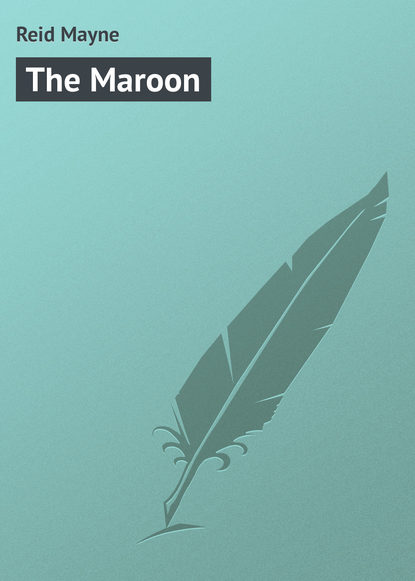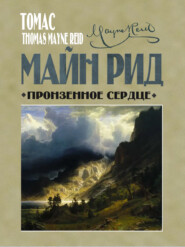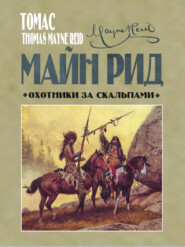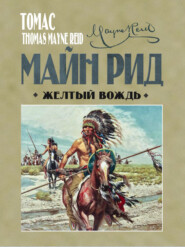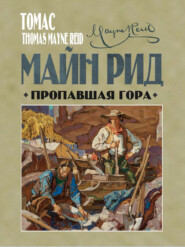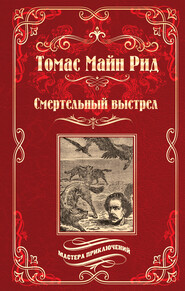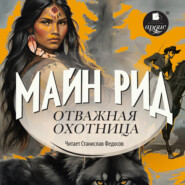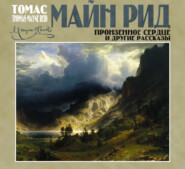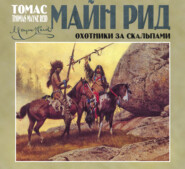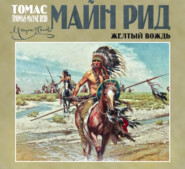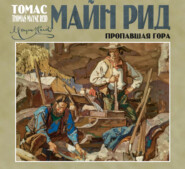По всем вопросам обращайтесь на: info@litportal.ru
(©) 2003-2024.
✖
The Maroon
Настройки чтения
Размер шрифта
Высота строк
Поля
The Maroon
Mayne Reid
Reid Mayne
The Maroon
Volume One – Chapter One
A Jamaica Sugar Estate
A sugar estate, and one of the finest in the “land of springs,” is that of “Mount Welcome.”
It is situated about ten miles from Montego Bay, in a broad valley, between two rounded ridges. These ridges, after running parallel for more than a mile, and gradually increasing in elevation, at length converge with an inward sweep – at their point of convergence, rising abruptly into a stupendous hill, that fairly merits the name which it bears upon the estate —the “mountain.”
Both the ridges are wooded almost down to their bases; the woods, which consist of shining pimento trees, ending on each side in groves and island copses, pleasantly interspersed over a park-like greensward.
The “great house” or “buff” of the estate stands under the foot of the mountain, just at the point of union between the two ridges – where a natural table or platform, elevated several feet above the level of the valley, had offered a tempting site to the builder.
In architectural style it is not very different from other houses of its kind, the well-known planter’s dwelling of the West Indies. One storey – the lower one, of course – is of strong stone mason-work; the second and only other being simply a wooden “frame” roofed with “shingles.”
The side and end walls of this second story cannot with propriety be termed walls: since most part of them are occupied by a continuous line of Venetian shutters – the “jalousies” of Jamaica.
These impart a singular cage-like appearance to the house, at the same time contributing to its coolness – a quality of primary importance in a tropical climate.
Outside in the front centre a flight of broad stone steps, resting upon arched mason-work, and bordered by strong iron balustrades, conducts to the level of the second storey – the real dwelling-house: since the ground-floor is entirely occupied by store-rooms and other “offices.”
The entrance door is from the landing of the aforesaid escalier, and conducts at once into the “hall” – a spacious apartment, of crucifix-shape, running clear across the building from side to side, and end to end. The current of air admitted by the open jalousies, passing constantly through this apartment, renders it at all times delightfully cool; while the lattice-work serves to mellow the glare of light, which, under the sky of the tropics, is almost as disagreeable as the heat. An uncarpeted floor, composed of the hardest sorts of native wood, and subjected to a diurnal polish, contributes to increase the coolness.
This great hall is the principal apartment of the dwelling. It is dining and drawing-room in one – where side-boards and cheffoniers may be seen in juxta-position with lounge chairs, fauteuils, and ottomans – a grand chandelier in the centre extending its branches over all.
The bed-chambers occupy the square spaces to one side of the cross; and these also have their jalousied windows to admit the air, and exclude, as much as possible, the sultry rays of the sun.
In Mount Welcome House, as in all other country mansions of Jamaica, a stranger would remark a want of correspondence between the dwelling itself and the furniture which it contains. The former might be regarded as slight, and even flimsy. But it is this very character which renders it appropriate to the climate, and hence the absence of substantiality or costliness in the style and materials of the building.
The furniture, on the other hand – the solid tables of mahogany, and other ornamental woods – the shining carved side-boards – the profuse show of silver and cut glass that rests upon them – the elegant couches and chairs – the glittering lamps and candelabras – all combine to prove that the quasi meanness of the Jamaica planter’s establishment extends no farther than to the walls of his house. If the case be a cheap one, the jewels contained in it are of the costliest kind.
Outside, the great house of Mount Welcome looks grand enough. Its broad façade, in which the deep green of the jalousies contrasts pleasantly with the white of the surrounding walls – the massive stone stairway in front – the wooded mountain sweeping up and forming a background of variegated green – the noble avenue of nearly a mile in length, with its double rows of tamarinds and cocoa-palms, leading up in front from the lower end of the valley – all contribute to produce a picture of almost palatial grandeur.
Nor does a nearer view detract from the splendour of this picture. The platform on which the house is built affords space for a large garden and shrubbery, extending rearward to the mountain-foot, from which they are separated by a high wall of stone.
The mountain is a conspicuous feature of the landscape. Not so much from its height: for there are others of equal elevation near to it; and further off, though still within sight, many still higher. Even the famed “Blue Peak” is visible, towering hundreds of feet above the surrounding summits.
Nor is it conspicuous from being isolated. On the contrary, it is only a spur of that vast elevated chain of hills, that, separated by deep gorge-like valleys, and soaring thousands of feet above the level of the Caribbean Sea, are known as the “Blue Mountains of Jamaica.”
Covering almost the entire area of the island – which is thus broken into an endless succession of gigantic corrugations – Jamaica presents a surface rough and irregular as the crumplings upon a cabbage-leaf; and “land of mountains” would be a title as appropriate as its ancient Indian appellation, “the land of fountains.”
The hill which overlooks the estate of Mount Welcome is less than two thousand feet above sea-level; but what renders it remarkable is the geometrical regularity of its outlines, and, still more, its singularly-shaped summit.
Viewed from the valley below, it presents the appearance of an exact and somewhat acute cone, up to within about fifty yards of its top. There the sloping outline ends – the line on each side thence trending vertically, and abruptly terminating in a square table-top, forty or fifty feet in diameter. In general appearance, this truncated summit is not unlike that of the famed “Cofre di Peroté” of Mexico.
The sloping sides of the mountain are densely wooded, especially that fronting the valley of Mount Welcome – towards which is presented a broad frowning façade, thickly clothed with a forest that appears primeval.
Alone at its top is it treeless – bare and bald as the crown of a Franciscan friar. There stands the square coffer-like summit, a mass of solid rock, which repels the approach of the vegetable giants that crowd closely around its base, some of them stretching out their huge arms as if to strangle or embrace it.
One tree alone has succeeded in scaling its steep rampart-like wall. A noble palm – the areca– has accomplished this feat, and stands conspicuously upon the table-top, its plumed leaves waving haughtily aloft, like a triumphal banner planted upon the parapet of some conquered castle.
This summit rock presents a singular appearance. Its seamed and scarred surface is mottled with a dark glaze, which during the sunlight, and even under the mellower beams of the moon, gives forth a coruscation, as if the light were reflected from scale armour.
To the denizens of the valley below it is known as the Jumbé Rock– a name characteristic of the superstitious ideas attached to it. Though constantly before their eyes, and accessible by an hour’s climbing up the forest path, there is not a negro on the estate of Mount Welcome, nor on any other for miles around, that would venture alone to visit the Jumbé rock; and to most, if not all of them, the top of this mountain is as much of a terra incognita as the summit of Chimborazo!
I am speaking of a period more than half a century ago. At that time the terror, that was attached to the Jumbé Rock, did not altogether owe its origin to a mere superstition. It had been partly inspired by the remembrance of a horrid history. The rock had been the scene of an execution, which for cruel and cold-blooded barbarity rather deserves to be called a crime.
That table-summit, like the blood-stained temples of the Moctezumas, had been used as an altar, upon which a human sacrifice had been offered up. Not in times long past, neither by the sanguinary priesthood of Azteca, but by men of white skin and European race – their victim a black and an African.
This incident, illustrating Jamaica justice during the dark days of slavery, deserves to be given in detail.
Volume One – Chapter Two
The Myal-Man
In the West Indies, a few years previous to the Emancipation, there was much agitation on the subject of Obeah-ism.
The practice of this horrid art had become appallingly common – so common that upon almost every extensive estate in the island there was a “professor” of it; in other words, an “Obeah-man.” “Professor,” though often used in speaking of these charlatans, is not a correct title. To have professed it – at least in the hearing of the whites – would have been attended with peril: since it was punishable by the death penalty. Practitioner is a more appropriate appellation.
These mysterious doctors were almost always men – very rarely women – and usually natives of Africa. Universally were they persons of advanced age and hideous aspect: the uglier the more successful in the pursuit of their criminal calling.
There was a class of them distinguished as “myal-men,” whose chief distinction consisted in their being able to restore life to a dead body.
Such was the belief of their ignorant fellow slaves, who little suspected that the defunct subject had been all the while only dormant, his death-like slumber secretly brought about by the myal-man himself, assisted by a prescription of the branched “calalue” – a species of caladium.
I cannot here enter into an explanation of the mysteries of Obi, which are simple enough when understood. I have met it in every land where it has been my lot to travel; and although it holds a more conspicuous place in the social life of the savage, it is also found in the bye-lanes of civilisation.
The reader, who may have been mystified about its meaning, will perhaps understand what it is, when I tell him that the obeah-man of the West Indies is simply the counterpart of the “medicine man” of the North-American Indians, the “piuche” of the South, the “rain-maker” of the Cape, the “fetish man” of the Guinea coast, and known by as many other titles as there are tribes of uncivilised men.
It is the first dawning of religion on the soul of the savage; but even when its malignant spirit has become changed to a purer aspiration after eternal life, it still lingers amidst the haunts of ignorance, its original form almost unaltered —witchcraft.
To the statement above made – that on every large plantation there was an obeah-man – the estate of Mount Welcome was no exception. It, too, was blessed, or rather cursed, by a follower of the art, an old Coromantee negro – Chakra by name – a man whose fell and ferocious aspect could not have failed to make him one of the most popular of its practitioners.
Such, to his misfortune, had he become.
He had long been suspected of having poisoned his master, the former owner of the estate, who had made an abrupt and mysterious exit from the world. The fate of this man, however, was not much lamented, as he bore the reputation of being a cruel slave-master. The present proprietor of Mount Welcome had least reason to regret it: since it gave him possession of an estate he had long coveted.
It was greater chagrin to him, that since entering upon the enjoyment of the property, several of his most valuable slaves had terminated their existence suddenly, and in a manner which could only be accounted for by the supposition that Obi had accomplished their destruction.
Chakra, the myal-man, was suspected of causing their deaths. He was arraigned and brought to trial.
His judges were three – three justices of the neighbourhood – for that number was sufficient to pass the death-sentence upon a slave. The president of the court was the man’s own master – Loftus Vaughan, Esquire, proprietor of Mount Welcome, and custos rotulorum of the precinct.
The substance of the crime charged against Chakra was “practising the arts of Obi.” The charge had no reference to the death of his former master.
Mayne Reid
Reid Mayne
The Maroon
Volume One – Chapter One
A Jamaica Sugar Estate
A sugar estate, and one of the finest in the “land of springs,” is that of “Mount Welcome.”
It is situated about ten miles from Montego Bay, in a broad valley, between two rounded ridges. These ridges, after running parallel for more than a mile, and gradually increasing in elevation, at length converge with an inward sweep – at their point of convergence, rising abruptly into a stupendous hill, that fairly merits the name which it bears upon the estate —the “mountain.”
Both the ridges are wooded almost down to their bases; the woods, which consist of shining pimento trees, ending on each side in groves and island copses, pleasantly interspersed over a park-like greensward.
The “great house” or “buff” of the estate stands under the foot of the mountain, just at the point of union between the two ridges – where a natural table or platform, elevated several feet above the level of the valley, had offered a tempting site to the builder.
In architectural style it is not very different from other houses of its kind, the well-known planter’s dwelling of the West Indies. One storey – the lower one, of course – is of strong stone mason-work; the second and only other being simply a wooden “frame” roofed with “shingles.”
The side and end walls of this second story cannot with propriety be termed walls: since most part of them are occupied by a continuous line of Venetian shutters – the “jalousies” of Jamaica.
These impart a singular cage-like appearance to the house, at the same time contributing to its coolness – a quality of primary importance in a tropical climate.
Outside in the front centre a flight of broad stone steps, resting upon arched mason-work, and bordered by strong iron balustrades, conducts to the level of the second storey – the real dwelling-house: since the ground-floor is entirely occupied by store-rooms and other “offices.”
The entrance door is from the landing of the aforesaid escalier, and conducts at once into the “hall” – a spacious apartment, of crucifix-shape, running clear across the building from side to side, and end to end. The current of air admitted by the open jalousies, passing constantly through this apartment, renders it at all times delightfully cool; while the lattice-work serves to mellow the glare of light, which, under the sky of the tropics, is almost as disagreeable as the heat. An uncarpeted floor, composed of the hardest sorts of native wood, and subjected to a diurnal polish, contributes to increase the coolness.
This great hall is the principal apartment of the dwelling. It is dining and drawing-room in one – where side-boards and cheffoniers may be seen in juxta-position with lounge chairs, fauteuils, and ottomans – a grand chandelier in the centre extending its branches over all.
The bed-chambers occupy the square spaces to one side of the cross; and these also have their jalousied windows to admit the air, and exclude, as much as possible, the sultry rays of the sun.
In Mount Welcome House, as in all other country mansions of Jamaica, a stranger would remark a want of correspondence between the dwelling itself and the furniture which it contains. The former might be regarded as slight, and even flimsy. But it is this very character which renders it appropriate to the climate, and hence the absence of substantiality or costliness in the style and materials of the building.
The furniture, on the other hand – the solid tables of mahogany, and other ornamental woods – the shining carved side-boards – the profuse show of silver and cut glass that rests upon them – the elegant couches and chairs – the glittering lamps and candelabras – all combine to prove that the quasi meanness of the Jamaica planter’s establishment extends no farther than to the walls of his house. If the case be a cheap one, the jewels contained in it are of the costliest kind.
Outside, the great house of Mount Welcome looks grand enough. Its broad façade, in which the deep green of the jalousies contrasts pleasantly with the white of the surrounding walls – the massive stone stairway in front – the wooded mountain sweeping up and forming a background of variegated green – the noble avenue of nearly a mile in length, with its double rows of tamarinds and cocoa-palms, leading up in front from the lower end of the valley – all contribute to produce a picture of almost palatial grandeur.
Nor does a nearer view detract from the splendour of this picture. The platform on which the house is built affords space for a large garden and shrubbery, extending rearward to the mountain-foot, from which they are separated by a high wall of stone.
The mountain is a conspicuous feature of the landscape. Not so much from its height: for there are others of equal elevation near to it; and further off, though still within sight, many still higher. Even the famed “Blue Peak” is visible, towering hundreds of feet above the surrounding summits.
Nor is it conspicuous from being isolated. On the contrary, it is only a spur of that vast elevated chain of hills, that, separated by deep gorge-like valleys, and soaring thousands of feet above the level of the Caribbean Sea, are known as the “Blue Mountains of Jamaica.”
Covering almost the entire area of the island – which is thus broken into an endless succession of gigantic corrugations – Jamaica presents a surface rough and irregular as the crumplings upon a cabbage-leaf; and “land of mountains” would be a title as appropriate as its ancient Indian appellation, “the land of fountains.”
The hill which overlooks the estate of Mount Welcome is less than two thousand feet above sea-level; but what renders it remarkable is the geometrical regularity of its outlines, and, still more, its singularly-shaped summit.
Viewed from the valley below, it presents the appearance of an exact and somewhat acute cone, up to within about fifty yards of its top. There the sloping outline ends – the line on each side thence trending vertically, and abruptly terminating in a square table-top, forty or fifty feet in diameter. In general appearance, this truncated summit is not unlike that of the famed “Cofre di Peroté” of Mexico.
The sloping sides of the mountain are densely wooded, especially that fronting the valley of Mount Welcome – towards which is presented a broad frowning façade, thickly clothed with a forest that appears primeval.
Alone at its top is it treeless – bare and bald as the crown of a Franciscan friar. There stands the square coffer-like summit, a mass of solid rock, which repels the approach of the vegetable giants that crowd closely around its base, some of them stretching out their huge arms as if to strangle or embrace it.
One tree alone has succeeded in scaling its steep rampart-like wall. A noble palm – the areca– has accomplished this feat, and stands conspicuously upon the table-top, its plumed leaves waving haughtily aloft, like a triumphal banner planted upon the parapet of some conquered castle.
This summit rock presents a singular appearance. Its seamed and scarred surface is mottled with a dark glaze, which during the sunlight, and even under the mellower beams of the moon, gives forth a coruscation, as if the light were reflected from scale armour.
To the denizens of the valley below it is known as the Jumbé Rock– a name characteristic of the superstitious ideas attached to it. Though constantly before their eyes, and accessible by an hour’s climbing up the forest path, there is not a negro on the estate of Mount Welcome, nor on any other for miles around, that would venture alone to visit the Jumbé rock; and to most, if not all of them, the top of this mountain is as much of a terra incognita as the summit of Chimborazo!
I am speaking of a period more than half a century ago. At that time the terror, that was attached to the Jumbé Rock, did not altogether owe its origin to a mere superstition. It had been partly inspired by the remembrance of a horrid history. The rock had been the scene of an execution, which for cruel and cold-blooded barbarity rather deserves to be called a crime.
That table-summit, like the blood-stained temples of the Moctezumas, had been used as an altar, upon which a human sacrifice had been offered up. Not in times long past, neither by the sanguinary priesthood of Azteca, but by men of white skin and European race – their victim a black and an African.
This incident, illustrating Jamaica justice during the dark days of slavery, deserves to be given in detail.
Volume One – Chapter Two
The Myal-Man
In the West Indies, a few years previous to the Emancipation, there was much agitation on the subject of Obeah-ism.
The practice of this horrid art had become appallingly common – so common that upon almost every extensive estate in the island there was a “professor” of it; in other words, an “Obeah-man.” “Professor,” though often used in speaking of these charlatans, is not a correct title. To have professed it – at least in the hearing of the whites – would have been attended with peril: since it was punishable by the death penalty. Practitioner is a more appropriate appellation.
These mysterious doctors were almost always men – very rarely women – and usually natives of Africa. Universally were they persons of advanced age and hideous aspect: the uglier the more successful in the pursuit of their criminal calling.
There was a class of them distinguished as “myal-men,” whose chief distinction consisted in their being able to restore life to a dead body.
Such was the belief of their ignorant fellow slaves, who little suspected that the defunct subject had been all the while only dormant, his death-like slumber secretly brought about by the myal-man himself, assisted by a prescription of the branched “calalue” – a species of caladium.
I cannot here enter into an explanation of the mysteries of Obi, which are simple enough when understood. I have met it in every land where it has been my lot to travel; and although it holds a more conspicuous place in the social life of the savage, it is also found in the bye-lanes of civilisation.
The reader, who may have been mystified about its meaning, will perhaps understand what it is, when I tell him that the obeah-man of the West Indies is simply the counterpart of the “medicine man” of the North-American Indians, the “piuche” of the South, the “rain-maker” of the Cape, the “fetish man” of the Guinea coast, and known by as many other titles as there are tribes of uncivilised men.
It is the first dawning of religion on the soul of the savage; but even when its malignant spirit has become changed to a purer aspiration after eternal life, it still lingers amidst the haunts of ignorance, its original form almost unaltered —witchcraft.
To the statement above made – that on every large plantation there was an obeah-man – the estate of Mount Welcome was no exception. It, too, was blessed, or rather cursed, by a follower of the art, an old Coromantee negro – Chakra by name – a man whose fell and ferocious aspect could not have failed to make him one of the most popular of its practitioners.
Such, to his misfortune, had he become.
He had long been suspected of having poisoned his master, the former owner of the estate, who had made an abrupt and mysterious exit from the world. The fate of this man, however, was not much lamented, as he bore the reputation of being a cruel slave-master. The present proprietor of Mount Welcome had least reason to regret it: since it gave him possession of an estate he had long coveted.
It was greater chagrin to him, that since entering upon the enjoyment of the property, several of his most valuable slaves had terminated their existence suddenly, and in a manner which could only be accounted for by the supposition that Obi had accomplished their destruction.
Chakra, the myal-man, was suspected of causing their deaths. He was arraigned and brought to trial.
His judges were three – three justices of the neighbourhood – for that number was sufficient to pass the death-sentence upon a slave. The president of the court was the man’s own master – Loftus Vaughan, Esquire, proprietor of Mount Welcome, and custos rotulorum of the precinct.
The substance of the crime charged against Chakra was “practising the arts of Obi.” The charge had no reference to the death of his former master.





